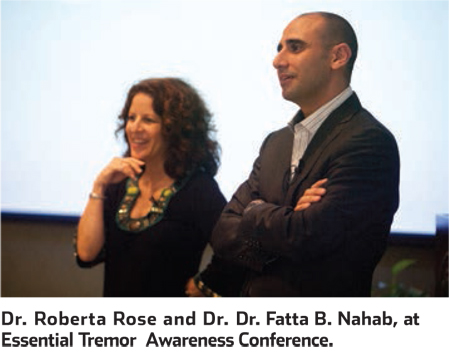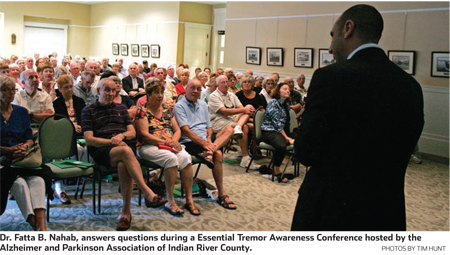The following is an article that was in the Vero Beach 32963 / February 14, 2013 Newsweekly by Siobhan McDonough, Correspondent.
Hector Rocafort remembers the day 15 years ago when his right hand started trembling for no apparent reason and from that point on mealtimes were a disaster. “I couldn’t eat properly,” he said of his efforts to use a fork with his dominant hand. “While eating a salad, a piece of lettuce would fly in one direction, a piece of tomato in the other. I’d be lucky if I could get a cucumber!” the 84-year-old retired police officer said last week at the Essential Tremor Awareness Conference hosted by the Alzheimer & Parkinson Association of Indian River County.
 Rocafort was one of 160 people who went to Northern Trust Bank on Thursday to hear doctors detail symptoms,
Rocafort was one of 160 people who went to Northern Trust Bank on Thursday to hear doctors detail symptoms,
causes, treatments and research associated with essential tremor, a progressive neurological disorder characterized by uncontrollable shaking of the hands and arms and sometimes other parts of the body including the legs, trunk, head, voice and chin. Some 10 million people in the United States have essential tremor. There is no known cause. Symptoms range from mild to severe and the condition affects mostly older people with symptoms worsening as they age. However, children can also experience essential tremor.
Joan Marie Barringer, a professional counselor, was only five years old when she started to tremor. She would have occasional episodes, especially during gym class when she was tasked to walk on the balance beam. “I was terrified. My whole body would start to shake.” She didn’t know what she had and was unable to supply an educated answer to family members, classmates and others who queried, “Why are you so nervous? Why do you shake so much?” “I felt frustrated and very alone,” said Barringer, who was eventually diagnosed at age 32 and later realized that she wasn’t the lone sufferer of essential tremor.
“It is a big secret for a lot of people,” she told the group, many of whom closely identified with her personal account of “feeling embarrassed and alone.” She encouraged people to attend support groups, to try a holistic mind, body, spirit approach to treatment in addition to a medical one, and to evaluate their diet and exercise.
Dr. Roberta Rose, a neurologist who practices in Vero and Sebastian, also spoke to the audience, offering an overview of essential tremor. While the condition can be debilitating it does not shorten a person’s life span, she said. It also doesn’t mean someone will develop Parkinson’s disease if they have essential tremor, however some research suggests that essential tremor can also occur with other brain and nervous system problems such as dystonia, parkinsonism and certain nerve conditions passed down through families.
There has been no medicine developed specifically to treat essential tremor, she said, however Propranolol, a beta blocker, and Primidone, a drug used to treat seizures, have been widely used and proven effective in some cases. Both drugs can have side effects.
In studies, alcohol and Botox have also shown to be effective in reducing certain tremors in patients. There is no single test to diagnose essential tremor, but a person with frequent tremors should have a thorough physical exam, have blood work done and a family medical history taken.
Rose implored those diagnosed with essential tremor to take things in stride. “If you take the right attitude, anything you are confronting will be easier, and that is as important as any medicine.”
She also discussed deep brain stimulation, a surgery for those with severe tremors that’s done to inactivate the thalamus, a structure deep in the brain that coordinates and controls muscle activity, without purposefully destroying the brain. Experts think that the abnormal brain activity that causes tremor is processed through the thalamus.
With brain stimulation, electrodes are placed in the thalamus during surgery. The electrodes are connected by wires to a type of pacemaker device called an impulse generator that is implanted under the skin of the chest below the collarbone. Once activated, the device sends continuous painless electrical pulses to the thalamus, blocking the impulses that cause tremors.
Patients can externally turn the generator on or off with a special magnet provided to them. Stimulators may last for several years, and the generator replacement procedure is fairly simple.
The stimulation provides moderate relief to about 90 percent of patients with essential tremor, studies show. Still, brain stimulation should only be considered in cases in which tremors significantly impair one’s lifestyle. Rose cautioned that surgery has risks, and the procedure is not for everyone.
However anxiety-stricken Jerry Peterson, 71, of Sebastian, was about having deep brain stimulation in 2009, his tremors had gotten so bad – he had lost his job in retail, and his fine painting skills were greatly diminished – he felt it was time to face his fears in the hopes of a favorable outcome.
And favorable, he got. “It was worth it,” he said after detailing his surgery with others. “It’s changed my whole life.”
 Dr. Fatta Nahab, a neurologist in Miami, wound up the conference with details on recent studies on essential tremor, and a status report. The bottom line: Whilst aggressive measures are being taken by researchers to pinpoint causes and origins of essential tremor, it remains largely a mystery.
Dr. Fatta Nahab, a neurologist in Miami, wound up the conference with details on recent studies on essential tremor, and a status report. The bottom line: Whilst aggressive measures are being taken by researchers to pinpoint causes and origins of essential tremor, it remains largely a mystery.
“Essential tremor is at a very critical time,” he said. “It’s a very difficult time for the field.”
No gene has been identified as associated with essential tremor. There is no known cause. No one knows how to customize treatment for what kind of tremor a person has. There are no medicines developed specifically for essential tremor. There is limited understanding of the causes, brain regions, medications and how the med[icine…]
“There are a lot of unanswered questions,” he said, urging people who are able to, to participate in case studies. “We need your help …… research moves forward, science advances because you all get involved.”
For Rocafort, brain stimulation was a step in the right direction. He has no regrets about his decision to have surgery, so much so that he is considering having another one done to improve his left hand’s functionality.“I feel like a new man,” he said buoyantly of the first go-around. “It’s a wonderful feeling.”
